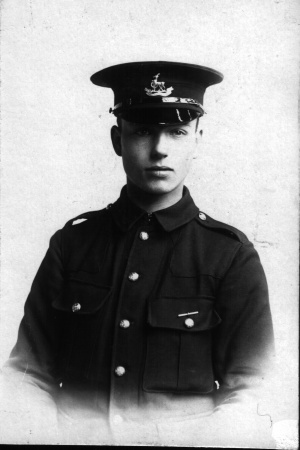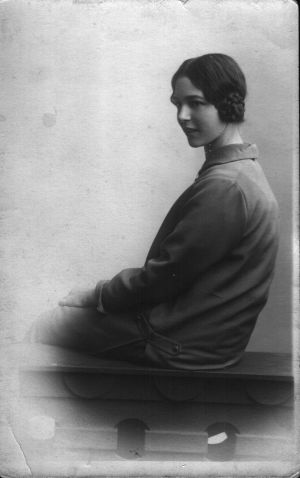Tenants at No 1
THE TENANTS OF NO. 1
This particular Salmon Family (and there were 3 different families all descended from Thomas and Sophie Salmon) were a great family who started off their married life living at No. 26 in The Square where two of the children were born, Ray and May. John (always called Jack) and Fanny were well-known Clifford people, with Jack's parents living at Eastcote Cottage, and Fanny's parents living at No. 50.
Fanny's maiden name was Woodward - another well-known Clifford name - , and after leaving No. 26, she and her husband settled in No. 1 living the rest of their married life together there. Percy arrived soon after their move, but Margery came along many years later as a "God-planned" baby.
Jack worked at the Clifford Mill (now flats) helping in the bakery and twice weekly delivering sacks of meal and bread to the neighbouring villages in a covered van drawn by old faithful Dobbin. His weekly wage was 18 shillings a week (90p now). He did receive tips - butter made by a farmer's wife, or a rabbit. He was a very keen gardener and kept Fanny well supplied with vegetables and herbs.
His other great love was bell-ringing and on St. Thomas' Day, he would leave his house soon after 5.30am and call up his fellow bell-ringers who would then meet in the belfry to start ringing a peal at 6.00am. He toiled out the Old Year and the New Year in, for 50 years.
Fanny, to help finances, worked as a seamstress at home, often working far into the night, with her husband holding a candle near her work to give her light to see. As they grew older, the children took over this job, and Margery can remember staying up until ten or eleven at night, holding the candle near to her Mother's care-worn hands as she worked. A lot of work consisted of undoing as well as stitching. Any garment showing good wear that fell into a mother's hands, was brought to Fanny to unstitch and make into a small garment for a child. In one case it was a coachman's jacket that was brought, for Fanny to undo all the panels and make them into a pair of trousers for a little youngster.
When the fruit-picking season came along, Fanny joined many other villagers in picking Seth Smith's fruit. She was one of the kindest people in the village, taking pity on the little children who had to walk many miles to school and who had 'accidents' on the way. Fearing the wrath of Miss Wilding on their soiled garments, they would go to No. 1 where Fanny would clean them up and provide them, where needed, with clean clothes.
Jack and Fanny were regular Church-goers, and Jack, having a good tenor voice, could be heard singing lustily by those in the back pew. Every Mothering Sunday, Jack would take his children for a walk to gather a bunch of wild flowers for Fanny. He was a very loving and tolerant man, and Margery's vivid recollection of him, was her sitting on the high back of his chair, brushing and combing his hair.
Ray, their oldest son, developed his father's fine singing voice. At the village school, Miss Wilding became aware of his beautiful voice. When school governors visited the school, then the school's academic progress was brought to the fore, but other visitors were given a display of the children's talents, and Ray was always asked, by Miss Wilding, to stand up before the visitors to sing "Killarney".
Ray was very particular in cleanliness, hygiene and appearance. "If the house was on fire," Jack often remarked, "our Ray would still be standing there by the mirror, combing his hair, with the flames raging around him."
It broke Fanny's heart, after Ray had left for France during the 1st World War, when news came back of the conditions of the trenches there. Ray had been called up and, indeed, it hurt all the family to think of their beloved Ray with his need for cleanliness, living, eating, sleeping in those terrible trenches with the mud, fleas and rats. Ray was tragically killed at the Battle of the Somme in 1916 just after his 22nd birthday.
Percy suffered too, during the War. He was a big lad and, after leaving school, started work at Stratford where, at the age of 15, he was taunted by women who did not realise his youth. He was called despicable names by them for not being at the front fighting with the boys. Percy could bear it no longer, and volunteered, celebrating his 16th birthday in Salonika. He was soon in the fighting well before his call-up age.
Just before the War broke out, an epic of scarlet fever swept through the village and little five-year old Margery was one of those who went down with the fever. She watched, from the window, as the terrible black horse-drawn van came along the village street, picking up those children with the fever. She knew that, when it stopped at her house, she would have to get in it and be taken away from her home and her family.
It was a terrible moment for the little girl, but the one who cried the most was her Mother, who saw her little child taken away. Margery, on arriving at the fever hospital in Birmingham Road, promptly developed mumps in addition to the scarlet fever. She was placed in a tiny ward on her own, but on Christmas Day, the nurses there decorated a little tree especially for her room.
Margery spent a lot of her time gazing out of the window in the hope of seeing her Mother. Fanny, during the bitter cold weather, would walk from Clifford, through Stratford, and along the Birmingham Road to the hospital where she would stand outside in the cold, waving and making signs to the little face at the window. Margery was especially thrilled when, very occasionally, her adored big brother Ray, also took the trouble to stand outside and wave to her, little realising that his main purpose in coming to the hospital was to see a certain nurse who worked there!
All during that terrible Christmas, Fanny scrimped and saved to buy her little daughter a present, to make up for the time she had spent away from her family, and when Margery eventually came home, there, as the front door opened, was a doll's pram with a beautiful doll inside it - all for her! That doll was her treasured possession for many years, and she cried bitterly when a cousin, in a fit of jealousy, broke all the fingers off each hand of her doll.
Not content with having scarlet fever and mumps, Margery then had whooping cough, and was dragged up Martins Hill every day by Fanny, who was convinced that the fresh air at the top of the hill would do her little daughter good.
May was born with a beautiful skin, a beautiful face and a beautiful nature, all of which she kept till her death. It amazed me to find out she was 94 when she went to her Heavenly Home, for there was not one wrinkle on her face. She and Margery both joined the choir when young girls and Margery became, and still was when I joined the Choir in 1967, Chief Choir Girl and continued as such until her death, with hardly a break throughout all those years.
May became a pupil teacher at the village school until the age of 16, when she went to work for a tartar of an Aunt in a Post Office. May was really made to work there and she had to live in too. Fortunately she was rescued by Jack Huckvale who worked in the Public Library, though she had to wait until the War ended before she could marry him in 1919. Then she was able to say goodbye to her aunt and went to live in Melton Mowbray where Jack junior and Barbara were born. Eventually, they returned to Clifford where Eileen was born, and May became very much a part of the village scene - Mothers Union, W.I. Magazine organiser, Over 60's Club, and, of course, everything connected to the worship of the God she loved so much.
Margery too, was a pupil teacher until the age of 17. Then she took a secretarial course, eventually finding a job at the N.F.U. She met a young man, Bob Tustain, a member of the Baptist Church who very soon began attending St. Helens in order to be near her. They married in 1936. Bob became a sidesman, and when he was called Home in 1983, had served for over 50 years as sidesman. It was lovely being greeted by him when you entered the Church, but I think the people who gained comfort from his tall stately figure, were those in the hospital wards waiting for his regular weekly visits. It started by him visiting a friend in hospital but, being Bob, he also chatted with the patients either side, and when his friend eventually left hospital, Bob carried on visiting the two new friends he had made - and chatting to the patients either side of them - and when those friends left......and so this continued right up until he left us.
Jack died in 1935 and Fanny lived on her own at No. 1 until the Second World War when she gave up her home to evacuees from London, and went to live with Margery and Bob Tustain. Fanny was approaching her 100th birthday when, at last, she was called Home in 1967 to join her husband and her two sons, Percy having died in 1964.
With the Salmon family splitting up and living in other areas of the village, new tenants moved in. One was a couple, a Mr. and Mrs. Ernie Slack who settled in well into the village, but Ernie spent a lot of his life on his own in that cottage, for his wife died sometime after their move there.
Ernie coped very well with the cooking and other housework involved. There seemed to be no children from the marriage.
It is believed that Seth Smith bought this cottage when the Manor Estate was sold, for Ernie never owned it. When Ernie reached way past retirement age, he was finding it a struggle to look after the property well, and he applied for a place as tenant in one of the Charity homes, and was successful at being accepted.
The property was sold by auction early 1970's – at an amazingly cheap price – probably because there were very few bidders – maybe only one! He had the money, paid for it, and renovated the house to how it looks now.







